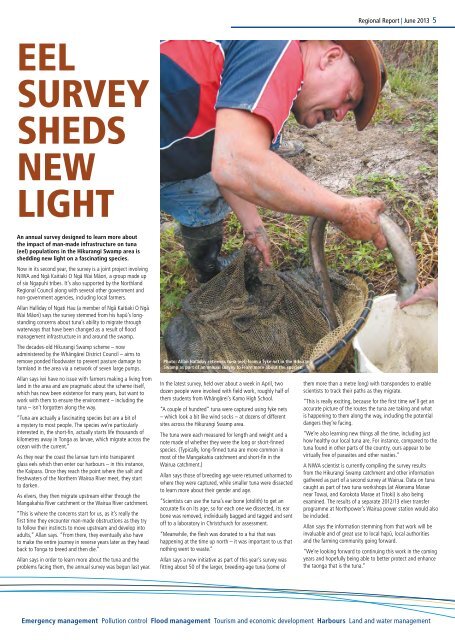Download PDF - Northland Regional Council
Download PDF - Northland Regional Council
Download PDF - Northland Regional Council
- No tags were found...
You also want an ePaper? Increase the reach of your titles
YUMPU automatically turns print PDFs into web optimized ePapers that Google loves.
<strong>Regional</strong> Report | June 2013 5EelsurveyshedsnewlightAn annual survey designed to learn more aboutthe impact of man-made infrastructure on tuna(eel) populations in the Hikurangi Swamp area isshedding new light on a fascinating species.Now in its second year, the survey is a joint project involvingNIWA and Ngä Kaitiaki O Ngä Wai Mäori, a group made upof six Ngapuhi tribes. It’s also supported by the <strong>Northland</strong><strong>Regional</strong> <strong>Council</strong> along with several other government andnon-government agencies, including local farmers.Allan Halliday of Ngati Hau (a member of Ngä Kaitiaki O NgäWai Mäori) says the survey stemmed from his hapü’s longstandingconcerns about tuna’s ability to migrate throughwaterways that have been changed as a result of floodmanagement infrastructure in and around the swamp.The decades-old Hikurangi Swamp scheme – nowadministered by the Whängärei District <strong>Council</strong> – aims toremove ponded floodwater to prevent pasture damage tofarmland in the area via a network of seven large pumps.Allan says iwi have no issue with farmers making a living fromland in the area and are pragmatic about the scheme itself,which has now been existence for many years, but want towork with them to ensure the environment – including thetuna – isn’t forgotten along the way.“Tuna are actually a fascinating species but are a bit ofa mystery to most people. The species we’re particularlyinterested in, the short-fin, actually starts life thousands ofkilometres away in Tonga as larvae, which migrate across theocean with the current.”As they near the coast the larvae turn into transparentglass eels which then enter our harbours – in this instance,the Kaipara. Once they reach the point where the salt andfreshwaters of the Northern Wairoa River meet, they startto darken.As elvers, they then migrate upstream either through theMangakahia River catchment or the Wairua River catchment.“This is where the concerns start for us, as it’s really thefirst time they encounter man-made obstructions as they tryto follow their instincts to move upstream and develop intoadults,” Allan says. “From there, they eventually also haveto make the entire journey in reverse years later as they headback to Tonga to breed and then die.”Allan says in order to learn more about the tuna and theproblems facing them, the annual survey was begun last year.Photo: Allan Halliday retrieves tuna (eel) from a fyke net in the HikurangiSwamp as part of an annual survey to learn more about the species.In the latest survey, held over about a week in April, twodozen people were involved with field work, roughly half ofthem students from Whängärei’s Kamo High School.“A couple of hundred” tuna were captured using fyke nets– which look a bit like wind socks – at dozens of differentsites across the Hikurangi Swamp area.The tuna were each measured for length and weight and anote made of whether they were the long or short-finnedspecies. (Typically, long-finned tuna are more common inmost of the Mangakahia catchment and short-fin in theWairua catchment.)Allan says those of breeding age were returned unharmed towhere they were captured, while smaller tuna were dissectedto learn more about their gender and age.“Scientists can use the tuna’s ear bone (otolith) to get anaccurate fix on its age, so for each one we dissected, its earbone was removed, individually bagged and tagged and sentoff to a laboratory in Christchurch for assessment.“Meanwhile, the flesh was donated to a hui that washappening at the time up north – it was important to us thatnothing went to waste.”Allan says a new initiative as part of this year’s survey wasfitting about 50 of the larger, breeding-age tuna (some ofthem more than a metre long) with transponders to enablescientists to track their paths as they migrate.“This is really exciting, because for the first time we’ll get anaccurate picture of the routes the tuna are taking and whatis happening to them along the way, including the potentialdangers they’re facing.“We’re also learning new things all the time, including justhow healthy our local tuna are. For instance, compared to thetuna found in other parts of the country, ours appear to bevirtually free of parasites and other nasties.”A NIWA scientist is currently compiling the survey resultsfrom the Hikurangi Swamp catchment and other informationgathered as part of a second survey at Wairua. Data on tunacaught as part of two tuna workshops (at Akerama Maraenear Towai, and Korokota Marae at Titoki) is also beingexamined. The results of a separate 2012/13 elver transferprogramme at Northpower’s Wairua power station would alsobe included.Allan says the information stemming from that work will beinvaluable and of great use to local hapü, local authoritiesand the farming community going forward.“We’re looking forward to continuing this work in the comingyears and hopefully being able to better protect and enhancethe taonga that is the tuna.”Emergency management Pollution control Flood management Tourism and economic development Harbours Land and water management
















